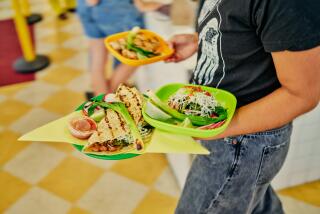BODY WATCH : Give Up Ethnic Food? Fat Chance! : The health police have done it again. Is this the end of global dining as we know it? Not if you follow these tips.
- Share via
Ethnic food lovers have been bombarded with so much bad news lately, can a support group and 800 line be far behind?
Chinese, Italian and now Mexican restaurant meals have all been skewered as unhealthy in recent surveys by researchers from the Center for Science in the Public Interest, the same spoilsports who bad-mouthed movie-theater popcorn.
In the latest study, released last week by the Washington, D.C.-based consumer organization, chiles rellenos took the heat. They’re as disastrous, it seems, as fettucini alfredo, previously christened “a heart attack on a plate” because it contains as much fat as in a stick of butter.
In another survey, CSPI deemed an order of kung pao chicken, with its 76 fat grams, as bad as eating nearly four Quarter-Pounders from Mickey D’s.
It’s enough to make a diner feel depressed, hungry, guilty--and torn:
To never again savor the sight, smell and taste of macho-sized burritos, pasta smothered in sauce, tangy sweet-and-sour shrimp?
Or to push forever from the brain the mental image of fat-filled test tubes, used as props at a news conference called by CSPI to demonstrate exactly how much of it is inhaled with a typical ethnic meal?
There’s definitely a backlash simmering.
Neva Cochran, a Dallas dietitian hired by insulted members of the Dallas-Fort Worth Chinese Restaurant Assn., picked 13 popular entrees and had the recipes analyzed at the prestigious Cooper Clinic in Dallas and found there are some healthful choices. Some take-out portions analyzed in the CSPI survey, she complains, were much bigger than what’s normally eaten at a restaurant.
As even CSPI researchers concede, lower-fat, lower-calorie dishes can be found at nearly any restaurant--with Mexican fare posing the biggest challenge. The trick is in the ordering.
We found three dietitians--all ethnic food aficionados--who agreed to share their secrets for ethnic, healthful eating. The experts:
* Ellen Coleman, a sports nutritionist at The Sport Clinic, Riverside.
* Martin Yadrick, a Manhattan Beach dietitian and training consultant for Computrition Inc., a nutrition software firm.
* Diane Whelan, a Westwood dietitian in private practice.
The strategy, in a low-fat nutshell: Know what to order. Know what not to order. And learn how to ask the chef or waiter to make your favorite entree less of a nutritional disaster.
Mexican
The first commandment of Mexican dining, says Yadrick: “Thou shalt not let the waiter set those tortilla chips down on your table.”
For good reason. “By the time the entree comes, especially if the service is slow and the company good, you can easily eat 500 calories worth of tortilla chips--and a fat load of about 26 grams,” says Yadrick. (To keep fat intake to 30% or less of calories as recommended, maximum daily fat grams should be 60-80 for most consumers.)
The better choice? “Ask for heated corn tortillas instead of chips. Tear them apart to dip into the salsa,” Coleman suggests.
When ordering main courses, remember these red flag words: fried, cheese, guacamole and sour cream. If you can’t eat a burrito sans sour cream, ordering it on the side might decrease your intake.
While the much-maligned chiles rellenos probably don’t belong on a weight-conscious person’s plate regularly, other Mexican dishes aren’t as bad, dietitians agree. “There’s nothing wrong, really, with a chicken soft taco,” Coleman says. “It’s not fried.”
Fajitas are OK, too. “Most contain small amounts of grilled, fairly lean meat, such as chicken or beef, along with green peppers and other vegetables,” Yadrick notes.
When ordering a tostada, ask your waiter to leave out the refried beans, which can be loaded with fat. Substitute steamed rice.
Eat at authentic Mexican restaurants rather than Americanized ones, Yadrick says, because he says they tend to use less cheese and other fatty toppings. Or choose the more health-conscious establishments (the Macheezmo Mouse chain, for instance, won the CSPI’s “Golden Tortilla Award” for healthful choices.)
Italian
“Keep it simple to keep it nutritious,” suggests Coleman. Begin with the bread basket. Skip the buttery garlic bread, since an order can contain 800 calories and 40 grams of fat. Ask instead for bread sticks. Or ask for plain bread, unbuttered, with some garlic seasoning on the side.
If you’re a famished breadaholic, pass on the bread altogether and order a low-fat appetizer that can be served right away. Minestrone soup is a great choice, Whelan says.
For main courses, pick pasta with marinara sauces over fat-filled cream sauces.
“There’s some olive oil in marinara sauce, but it’s nothing (fat gram-wise) compared with cream sauces,” Coleman says. Pesto sauce--with its basil, pine nuts and oil--may sound healthy, but it’s usually high in fat, Coleman says.
Clam sauces look sinful but aren’t always. The CSPI survey found that linguine with white clam sauce got just 29% of calories from fat.
Skip any kind of pasta with cheese filling, which can rack up the fat grams faster than you can say “Abbondanza!” Pass, too, on lasagna, described by CSPI as “a plate of greasy meat and cheese.”
Plain cheese or vegetarian pizzas are good choices. “Choose deep dish over regular, because the more crust, usually the less cheese and toppings,” Coleman says. Eggplant parmigiana sounds like a healthy vegetarian’s delight--but CSPI found 14 teaspoons of fat in a single serving.
Spaghetti and meatballs might not be a bad choice, either, Yadrick says. The meatballs are often made with a filler such as low-fat bread crumbs. And they’re bound to pack less of a fat wallop than Italian sausage.
Chinese
Appetizers at Chinese restaurants can be the real villains, fat wise. Skip the egg rolls and won-tons. Ditto those little noodles, the Chinese equivalent of tortilla chips, dietitians say.
A better choice? “Bird’s nest soup--basically broth with noodles,” Coleman says, not to metion the bird’s nest. Pass on the egg drop soup; it’s higher in fat.
For an entree, choose stir-fried and steamed dishes, when possible, over anything battered and fried. Sichuan Shrimp is often a good choice, too, Coleman says. In the Center survey, Sichuan shrimp and stir-fried vegetables were the two top-rated dishes. Avoid sweet-and-sour pork, pressed duck and barbecued ribs, all usually high in fat.
Steamed rice is healthier than fried. But if Chinese just doesn’t seem Chinese without fried rice, fried rice with vegetables is lower-fat than fried rice with pork, Whelan suggests. If you must have cashew chicken, try not to eat many of the nuts.
If you’re dining with a crowd and will share dishes, order just one meat dish and the rest vegetable- and rice-based, automatically reducing fat and calories.
Ask the chef to omit MSG and salt. But salt’s hard to avoid in Chinese cuisine, Coleman notes.
Plan B: Decrease sodium intake for the next few meals or even the next few days to compensate.






